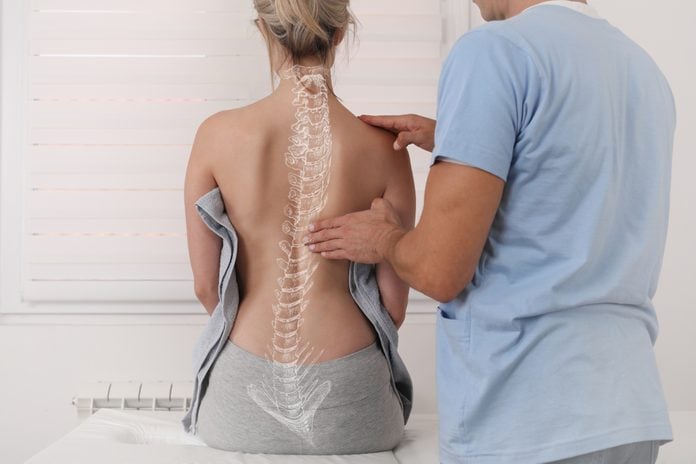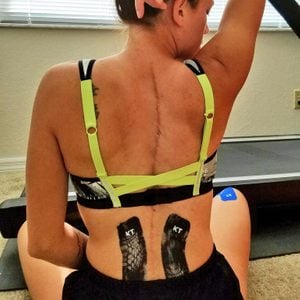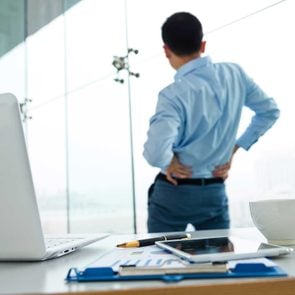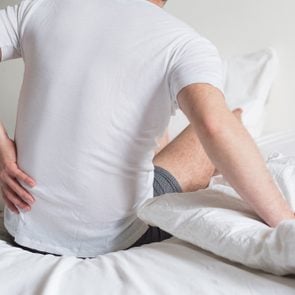What Is Mild Scoliosis? Here’s Everything You Need to Know
Updated: Mar. 11, 2022
Mild scoliosis—a curve of the spine—is more common than severe scoliosis and doesn't usually need treatment. Here's what to know about the condition.
A curved spine
When a person has scoliosis, it means they have a curve in their spine. “If you are looking at someone [from the back], instead of their spine appearing totally straight, there is an S-shaped curvature to it,” says spine surgeon James Lin, MD, an assistant professor in the Department of Orthopedic Surgery at the Icahn School of Medicine at Mount Sinai in New York City.
While this may sound scary, scoliosis is often mild—hence the name mild scoliosis—and causes no harm. (These are the everyday habits damaging your spine.)
According to the National Scoliosis Foundation, 2 to 3 percent of the population has scoliosis, although Daniel Hedequist, MD, an orthopedic surgeon and chief of the spine division at Boston Children’s Hospital, believes the number is higher. “I’d say about 10 percent of the population has some bit of curve,” he says. “There are plenty of people walking around with scoliosis who don’t even know it.”
Here’s everything you need to know about mild scoliosis, including causes, symptoms, diagnosis, and treatment options.
What is mild scoliosis?
The word “scoliosis” probably conjures images of torso braces and complicated spine surgery. But there’s a range of severity.
Scoliosis is described using something called a Cobb angle, a measure of the degree of curvature. “If it’s less than 10 degrees, that’s normal,” says Sumeet Garg, MD, associate professor of orthopedics at the University of Colorado School of Medicine and pediatric spine surgeon at Children’s Hospital Colorado.
If the curve is greater than 10 degrees, you have scoliosis. While there is no official definition of mild scoliosis, Dr. Garg says that generally speaking, severity is broken down like this:
- Mild scoliosis: 10 to 25 degrees
- Moderate scoliosis: 25 to 50 degrees
- Severe: 50 degrees or more
A person can develop mild scoliosis at any age, but it’s most commonly diagnosed in adolescence, between the ages of 10 and 14, says Dr. Garg. Scoliosis is more common in girls than boys, according to Dr. Hedequist.
(Here’s what to know about wearing a brace for lower back pain.)
What causes mild scoliosis?
For the most part, scoliosis lacks an obvious cause. It may run in families, but that’s not always the case.
“We definitely see families that have a strong family history, but we have children present all the time that have no family history and have curves that already need surgery,” says Dr. Hedequist, who is also an associate professor of orthopedic surgery at Harvard Medical School in Boston.
In adults, mild scoliosis can be idiopathic, or it can be caused by degeneration of the spine. “Some adults, as they age, can develop arthritis in their spine,” says Dr. Garg. Unlike idiopathic scoliosis in childhood, this type of scoliosis, even when mild, can cause back pain.
What are the symptoms of mild scoliosis?
Scoliosis symptoms vary depending on the degree of severity. However, there are some common symptoms to look for:
- Uneven hips
- One shoulder blade higher than the other
- One shoulder blade sticks out more than the other
- Rotation or twist of the spine
- Gait changes
- Balance and coordination changes
- Back pain
- Ill-fitting clothing (uneven neckline, shirt sleeves, etc.)
How is mild scoliosis diagnosed?
In kids, mild scoliosis doesn’t cause pain or limit their activities. That means a diagnosis typically comes after someone notices the curve. Kids will often be screened by pediatricians at yearly checkups, or at their school. “You might notice it if your child’s at the beach with a bikini on, or a boy with just swim trunks on,” says Dr. Hedequist.
When doctors check for scoliosis, they look for symmetry. Dr. Hedequist says they’ll consider factors like whether your shoulders are level or asymmetrical, whether your shoulder blades stick out, and if your waist is straight or there’s a curve on one side.
If a doctor asks your child to bend over, they are looking to see if the muscle of the rib looks rotated or higher. “That’s a sign you have rotation to sub spine, which is a sign of scoliosis,” says Dr. Hedequist.
In some instances, scoliosis is discovered by fluke. “The most common reason a patient with mild scoliosis comes to see me is because they had an X-ray for another reason that showed their scoliosis,” says Dr. Lin.
Once a curve is identified, a specialist will measure it in one of two ways. A scoliometer, a special device similar to a level, is placed on the spine while a patient is bent forward in order to measure the angle at which the spine curves. An X-ray can also measure the angle.
Treatment for mild scoliosis
How mild scoliosis is treated and managed depends on the age of the patient.
Children
Kids with mild curves in their spine need to be monitored to see if the curve progresses, says Dr. Hedequist. The risk of their curve becoming serious enough to need treatment—either bracing or surgery—depends on how old they are and the amount of curve they already have.
“If you have a little curve with not a lot of growth left, you don’t have much to worry about,” he says. “If you have a lot of curve with a lot of growth left, you have a lot to worry about.”
Adolescents
If a child has gone through puberty and finished growing, then their mild curve is unlikely to get any worse. In this case, the person can just go on with their life. “Once you’re done growing, those curves don’t cause any long-term problems into adulthood,” says Dr. Hedequist. “You don’t have any higher incidence of pain or of psychosocial dysfunction. It also doesn’t affect athletic activity or career choices.”
Adults
Adults with mild scoliosis may benefit from physical therapy if they are experiencing pain, says Dr. Garg. If you are not experiencing symptoms, then you don’t need any treatment.
(Check out the best mattresses for scoliosis support.)
Physical therapy for mild scoliosis in kids
Many parents wonder if physical therapy exercises will improve their kid’s curve, or stop it from getting worse. There is no evidence that exercise will improve scoliosis, but Dr. Garg says there’s some evidence it may stop a curve from getting worse. “It’s really pretty limited evidence,” he says. “But we do offer it as a treatment if families want it.”
(These are the best exercises for lower back pain.)
Dr. Hedequist agrees. “One of the most frequently asked questions is, ‘Does my child need physical therapy for their mild scoliosis?’ In general, the answer is no,” he says. “There are some families that would like to work on some posture and strengthening and trying to retrain muscles to have their child standing straighter. If they want to do that, we do support that.”
Dr. Garg notes that while there are some generalized back exercises that can help with back and core strengthening, scoliosis-specific exercises need to be tailored to the individual’s curve. Not just any physical therapist will do. “You need to be someone who has specialized training in scoliosis physical therapy.”
(These are the best stretches for lower back pain and the best stretches for upper back pain.)
The last word
A scoliosis diagnosis can range from mild to severe. Depending on the degree, it may or may not interfere with how you perform everyday activities. Doctors generally diagnose mild scoliosis in adolescence and monitor its progression in severity as kids grow. It’s important to talk with your doctor to determine the best type of scoliosis treatment for the level of curvature in your spine.
In the end, mild scoliosis is typically not an issue and doesn’t impact daily life. For young kids with mild scoliosis, the biggest concern is that the curve will get more severe. That’s where Dr. Garg hopes scientific understanding of scoliosis will improve.
“Hopefully in the future, we can better understand the biology of it,” he says. “Maybe there’ll be biological markers that could tell us, ‘This kid has a 20-degree curve, but based on their genetics or some factor in their blood, they have a very low risk of progression.'”
Next, try these back pain exercises to feel better.




